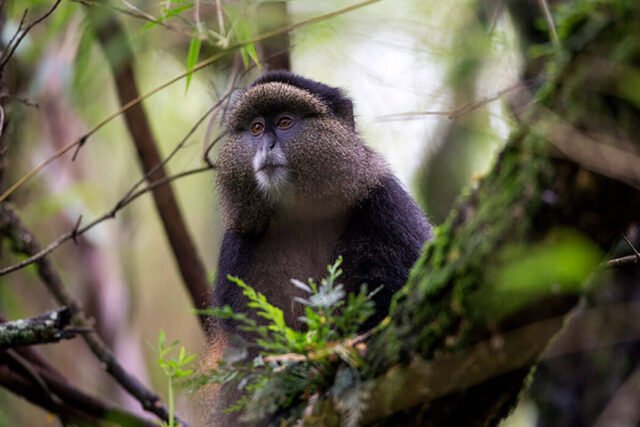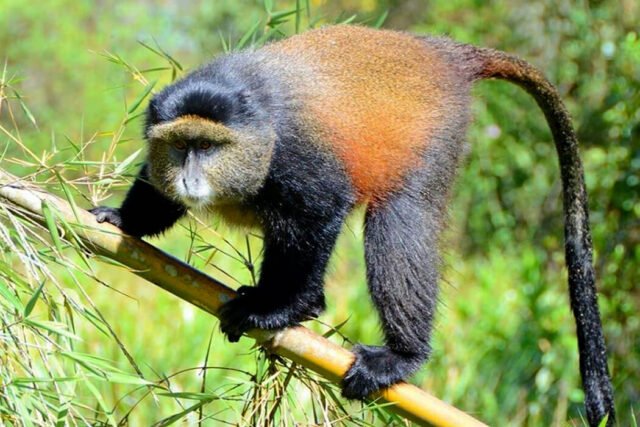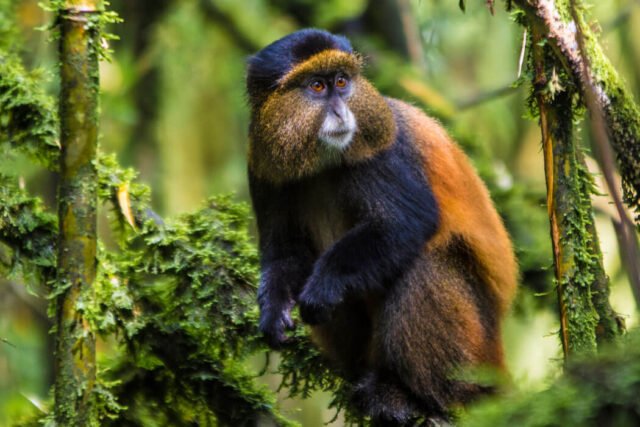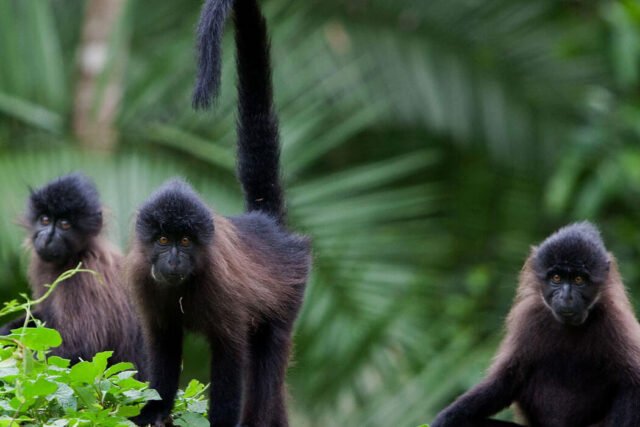The golden monkey is another primate species that are listed as endangered. Like mountain gorillas, golden monkeys can only be found in Uganda, Rwanda and the Democratic Republic of Congo.
The golden monkey is scientifically known as Cercopithecus mitis kandti. Golden monkeys are considered an endangered species as they only live in the Virungas and come to about 4000 animals in total.
Golden monkeys can be found in in the Virunga volcanic region that spans from Northern Rwanda, Eastern Congo and Southwestern Uganda.

Golden Monkeys Facts Worth Knowing
1. Physical Characteristics
The statement ‘what you see is what you get’ probably originated from this. Or it was not a creative naming day. Golden monkeys are named after the way they look. Literally.
With golden-orange patch straight from their long tail to its back and cheeks and some darker patches on the legs, arms and face giving them a weird but captivating look from the other primate animals in the wild.
The females are much lighter than the males.
The male monkeys range between 48 and 67 centimeters and females 46 to 53 centimeters, rendering them slightly smaller. The males can weigh approximately 4.5 to 7 kg while the females go up to about 3.5 to 4.5 kg. In case you were expecting large animals, they are not.

2. Habitat of Golden Monkeys
Golden monkeys can be found in Mgahinga, Volcanoes and Virunga national parks of Uganda, Rwanda and D.R.Congo respectively. These parks are next to each other and only separated by the international borders.
Golden monkeys cannot be found elsewhere in the world and are endemic to this area.
They like high altitude areas with lots of vegetation, fruit and bamboo which makes the major part of their intricate diet.
During the rainy season, the bamboo is abundant – which is favorable for the golden monkeys to create homes, near a source of the abundant food supply. In the dry season with less bamboo, some of them move on to the rest of the mountains in search of fruits and other edible plants.
3. Golden Monkey Diet
Golden monkeys are herbivores. They are anatomically and physiologically wired to feed on plant materials, they are known for eating about 20 to 30 types of plants and an occasional insect (invertebrates) found on leaves. However, they are most commonly known for feeding on bamboo leaves especially in the rainy season.
When wild fruits are in season, golden monkeys will eat lots of fruits but will divert back to the always available bamboo once the season is over.

4. Social Behavior
Golden monkeys are social animals that live in groups of 30 to 80 individuals. The male golden monkey is the head of the group and has the authority to mate with all the females in the group.
These groups vary in sizes according to the altitudes of their habitats. Most of the golden monkeys in higher altitude areas live in smaller groups compared to their counterparts in lower altitude.
Among golden monkeys, females are responsible for ensuring the safety of their territories and offspring until they are old enough (and the for males to be out there on their own).

Golden monkeys love comfort and sleep in groups of four in thick bamboo areas that provide enough shelter to sleep during the night.
Less known fact, in some instances, they create habitats for themselves by weaving bamboo together to create a home, much like humans.When they feed from a distant area, it is still close enough to allow them to move back to the habitat later in the day. You could say they are domestic in that special way.
This is unlike gorillas which build a new sleeping nest every day and never use it again.
5. Lifecycle
Like most animals in the wild, golden monkeys have polygamous relationships. The male monkey in the group mates with all the females.
Interestingly, the females are the initiators of this mating ritual.
The gestation period takes five months and the young infant is born with fur and eyes wide open. The mother takes care of the baby for about two years before it is given any freedom.
When they are old enough, the young monkeys can go and join other groups, or even start their own families.
Golden monkeys can live up to 19 years. While this is not as long as chimpanzees and gorillas which can make 50 years, this is about average for smaller monkeys – and longer than lions or leopards in the wild.

Conclusion
Golden monkeys are generally very playful (even by the standards of monkeys) and they are a joy to look at. Most people who come to Uganda to track golden monkeys usually bundle it up with a wildlife and gorilla trekking safari.
For those who are fascinated with primates, the highlight of Uganda and Rwanda safaris is usually seeing chimps, gorillas, golden monkeys and the other primate species like baboons, colobuses and L’ Hoest monkeys.
If you are interested in tracking golden monkeys (and the other primates) don’t hesitate to contact us about your specific needs. Our team will be eager to assist.








